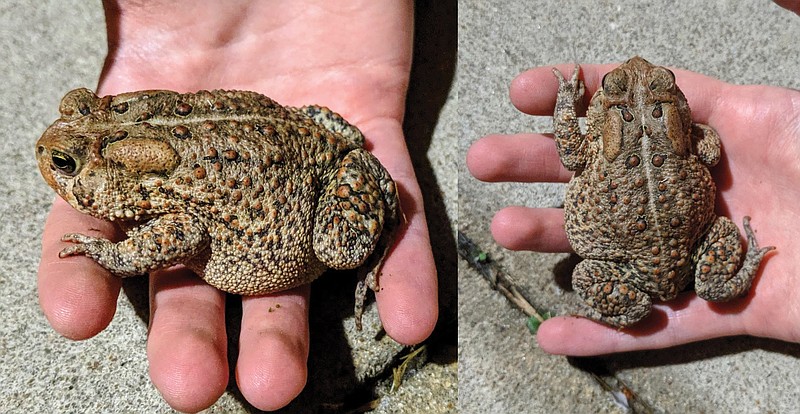They're chunky, they're warty and they're a gardener's pal.
Toads play a vital role in Missouri's ecosystem, and they're full of surprises, according to Missouri Department of Conservation Naturalist Alan Reed. Reed gave a virtual talk on toads Tuesday as part of the MDC's ongoing effort to host online programming during the pandemic.
"Toads are great animals to have around the garden," Reed said. "They eat lots of insects. I have several in my garden around my bean plants."
Like frogs, toads are amphibians - they start as tadpoles and must visit the water to reproduce. But true toads have their own family, Bufonidae; they're distinct from frogs in a number of ways.
"Toads have that warty skin, they spend a lot of time out of the water and they don't have any teeth," Reed said.
Frogs, by comparison, must spend most of their time in the water. Frogs' toes are webbed, while toads' toes are not. Frogs have long legs suitable for jumping and leaping, while toads must hop and crawl. And, though few know it, most frogs have tiny teeth on their upper jaw. Additionally, all four species of toad present in Missouri have horizontal slit-shaped pupils, while the frogs have vertical pupils.
Perhaps most obviously, toads have dry, warty skin, while a frog's skin is wet and smooth.
"Some people think they can catch warts from the toad, but that's not true, they don't give people warts at all," Reed said. "Warts are typically caused by a virus and toads don't carry that virus."
All of Missouri's four species of true toads can be found in Callaway County.
The Woodhouse's toad (Anaxyrus woodhousii woodhousii), Fowler's toad (Anaxyrus fowleri) and Eastern American toad (Anaxyrus americanus americanus) live all along the Missouri River. They like to live in woods and gardens. All three look quite similar and are best distinguished through their calls.
The American toad can sometimes be distinguished by the number of warts per spot on its back - typically just one or two - and the way the bony crest atop its head points back toward its paratoid glands (the oval lumps on either side of its head). The Fowler's and Woodhouse's toads both usually have one to six warts per spot, and both make a similar call: "Waaaah." However, a Woodhouse's toad's call is slightly lower and shorter.
"You have to have a pretty good ear to tell the difference," Reed acknowledged.
Missouri's fourth species of toad, the Great Plains Toad (Anaxyrus cognatus), is much less common - it lives only in the Missouri River floodplain from the northwestern corner to the central part of the state. According to MDC's distribution map, Callaway County is the furthest east it ventures. They have cream or tan skin covered in large brown or green blotches, and their call is a loud, piercing "chee-ga, chee-ga, chee-ga." They're less likely to show up in town, preferring to live in prairies and open floodplains.
Slow, lumbering toads seem like they'd make a tasty treat for a predator, but they have two built-in defenses. Both involve convincing a potential predator toads are too gross to eat.
When toads visits a pond or a puddle, they absorb water through a patch on their underside and store it in a bladder. When a predator - or a curious human - picks a toad up, they release the water.
The other defense lies in the toad's paratoid glands. These glands produce a toxic substance called bufotoxin, which oozes out as a milky white substance when the toad is disturbed. Bufotoxin tastes awful and can irritate a predator's mouth. It's unlikely to cause harm to a human or a human's pets unless the toad is swallowed, Reed said.
"I had a golden retriever, her name was Annabelle, who was, bless her heart, dumber than dirt," Reed recalled. "She'd pick up every toad she could find, then spit it out, then pick it up, and spit it out. She'd begin to salivate from the bufotoxin but it didn't hurt her."
Raccoons have mastered the art of toad-eating - they simply bite off the toad and leave the paratoid glands behind.
Finding a toad around Callaway County is easy enough. Choose a warm night, grab a flashlight, and walk to the nearest street light or other outdoor light source. A toad may often be found hunting the insects attracted to those lights, even in Fulton's neighborhoods. In the spring, spot toads mating and laying eggs in ponds, ditches and large puddles.
"Toad eggs are kinda like strings of black pearls," Reed said. "They can lay up to 20,000 eggs. But not all of those eggs are going to hatch or make it through larval stage."
When the water is warm, it can take those eggs as little as two days to hatch, he added. Tadpoles mature into tiny toadlets in six to eight weeks.
Over the winter, toads snooze in burrows.
It's legal for Missouri residents to possess up to five toads, raised from eggs or caught as adults or tadpoles. Reed showed off one handsome female toad that lives at the Springfield Conservation Nature Center.
"If you want to have a toad for a pet, you can do that, but you want to make sure you vary their diet," Reed said. "You want to feed them different bugs and larvae. They like to eat worms - they love a worm too. They don't eat pizza though, just so you know."
To learn more about toads and the other delightful amphibians you might find in Callaway County and elsewhere in Missouri, read MDC's publication "Missouri's Toads and Frogs for free here. To view and register for upcoming virtual programs, visit mdc.mo.gov/events.

